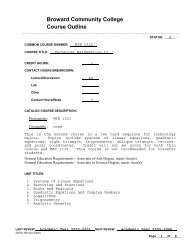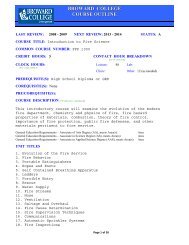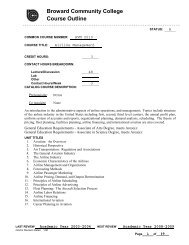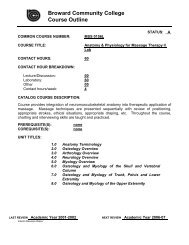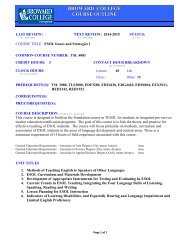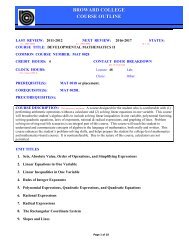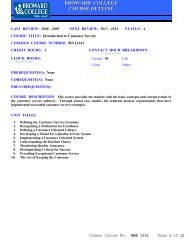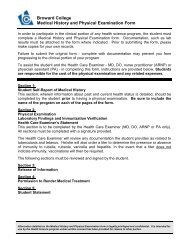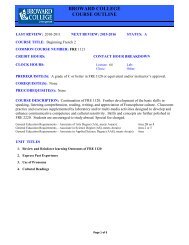GLY1010.pdf - Broward College
GLY1010.pdf - Broward College
GLY1010.pdf - Broward College
Create successful ePaper yourself
Turn your PDF publications into a flip-book with our unique Google optimized e-Paper software.
BROWARD COLLEGECOURSE OUTLINELAST REVIEW: 2010-11 NEXT REVIEW: 2015-2016 STATUS: A(i.e. 2006-2007) (i.e. 2011-2012) (A, I, D)COURSE TITLE: Physical GeologyCOMMON COURSE NUMBER: GLY1010CREDIT HOURS: 3CONTACT HOUR BREAKDOWN(Per 16 week term)CLOCK HOURS: Lecture: 48 Lab:(Voc. Course ONLY)Clinic:Other:PREREQUISITE(S): NoneCOREQUISITE(S): NonePRE/COREQUISITE(S):COURSE DESCRIPTION (750 characters, maximum):Study of geologic agents, minerals, rocks, structure, and land forms. The effects of geologic events upon life andhuman relations are discussed. Students registering in GLY 1010 are strongly urged to register in the companionlaboratory GLY 1010L. Some senior institutions require a 4-credit geology course.General Education Requirements – Associate of Arts Degree (AA), meets Area(s): Area 4BGeneral Education Requirements – Associate in Science Degree (AS), meets Area(s): Area 4BGeneral Education Requirements – Associate in Applied Science Degree (AAS), meets Area(s): Area 4UNIT TITLES1. Reading and Writing in the Geological Sciences2. Introduction3. Earth Materials4. Surface Processes5. Earth’s Structure6. Earth through TimePage 1 of 11
BROWARD COLLEGECOURSE OUTLINE*** Complete the following only if course is seeking general education status ***GENERAL EDUCATION Competencies and Skills *:In the box to the right of the Competency/Skill, enter all specific student learning outcome unit numbers, as indicated in the course outline(i.e. 1.1, 2.7, 4.2, 4.0 and 5.12) that apply.Course must include all of the following:1. Read with critical comprehension** 1.02. Write clearly and coherently** 1.0 , 2.10, 3.1, 3.3, 3.4, 5.93. Demonstrate literacy as appropriate within a givendiscipline**a) Information b) Technologyc)Workplaced) Culturale) Quantitative f) Scientificg) Environmental4. Apply problem solving skills or methods to makeinformed decisions in a variety of contexts**b. 5.7d. 2.3, 2.6, 2.8e. 6.4-6.5f. 1.0-6.6g.2.3, 4.4, 4.7, 4.14-4.18, 5.64.6, 4.15-4.18, 5.4, 5.6, 6.5,Course must include at least one of the following:5. Differentiate between ethical and unethical behavior 4.15-4.186. Demonstrate an understanding of the physical,4.7, 4.12, 4.14-4.18biological, and social environments and how individualbehaviors impact this complex system.7. Demonstrate an understanding of and appreciation for 2.6human diversities and commonalities.8. Speak and listen effectively.*General Education Competencies and Skills endorsed by 2010-2011 General Education Task Force**Required Competencies1) Read with critical comprehension.The student will be introduced to the basic texts, concepts, vocabulary, and methods necessary for developingan understanding of the discipline and meeting the required benchmarks as stated in the course outline.2) Write clearly and coherently.The student will demonstrate an understanding and mastery of subject matter in a variety of ways, includingwriting. Writing activities may include both graded and ungraded essays, short answer quizzes, summaries,reactions, journals, and various other reports.3) Demonstrate and apply literacy across all the disciplines (indicate which ones apply).a) Information literacy means understanding how to locate needed information, using the appropriatetechnology for the task, managing and evaluating the extracted information and using it effectively andethically.b) Technology literacy is the ability to responsibly and effectively use appropriate technology to access,manage, integrate, or create information, and/or use technology to accomplish a given task.c) Workplace literacy is having the appropriate knowledge and skills to communicate and work withothers effectively and perform job duties, whether it is through the use of computers and/or othertechnology.d) Cultural literacy is recognizing, understanding, and appreciating the similarities and differencesbetween one’s own culture and the cultures of others through a study of the arts, customs, beliefs,values, and history that define a culture.e) Quantitative literacy is having the ability to formulate, solve and interpret mathematical/statisticaloperations and graphical/tabular representations to make informed decisions.Page 2 of 11
BROWARD COLLEGECOURSE OUTLINEf) Scientific literacy means understanding the methodology and application of the scientific process, thephysical and biological worlds, and recognizing that scientific knowledge is continuously updated orrevised as new information is discovered.g) Environmental literacy is creating a context within which environmental issues can be viewed,imparting knowledge to enhance one’s ability to analyze the issues, make the connections betweenhumans’ decisions and actions and the challenges facing the environment, and instilling the desire tosustain the environment through ethical practices in both one’s professional and personal lives.4. Apply problem-solving skills or methods to make informed decisions in a variety of contexts.The student will use acquired skills or methods to recognize, analyze, adapt, and apply criticalthinking to solve problems and make informed decisions.Page 3 of 11
BROWARD COLLEGECOURSE OUTLINEEVALUATION:In the box to the right of the Methods of Assessment, enter all specific learning outcome numbers (i.e. 1.1, 2.7, 4.0, 4.2 and 5.12) that apply.1. Portfolio2. Short essays3. Research Papers4. Group projects5. Discussions (In class and online) 1.0-6.06. Multiple Choice tests 2.2, 2.4-2.8, 3.1-3.7, 4.1-4.3, 4.5, 4.8-4.12, 5.1-5.2, 5.4-5.9, 6.1-6.2, 6.67. Presentations8. Service Learning Projects9. Quizzes (pop, announced, etc.) 2.2, 2.4-2.8, 3.1-3.3, 3.5, 4.1-4.3, 4.5, 4.8-4.12, 5.1-5.2, 5.4-5.9, 6.1-6.2, 6.610. Take-home tests11. Summaries, critiques, and analyses 4.15-4.1812. Reaction papers13. Surveys14. Performance15. Short answer tests 2.3, 2.5-2.8, 4.2, 4.4-4.8, 4.12, 4.14, 5.1-5.2, 5.4-5.6, 5.7, 5.9, 6.1, 6.3-6.616. Classroom debates and colloquia17. Blogs, wikis, web pages18. Other (Please explain) Demonstrations: 5.3, 6.2Page 4 of 11
BROWARD COLLEGECOURSE OUTLINECommon Course Number: GLY1010UNITSUnit 1: Reading and Writing in the Geological SciencesGeneral Outcome:1.0 The students shall be able to clearly communicate in writing informationderived from course related readings the major concepts and themes in thegeological sciences.Specific Measurable Learning Outcomes:Upon successful completion of this unit, the students shall be able to:1.1 Demonstrate in writing the ability to analyze, evaluate, compare, and/or extract data relevant togeology from course related readings.1.2 Evaluate the validity of information from a variety of sources, including electronic/print sources anddata bases.1.3 Illustrate using diagrams, drawings, outlines, concept maps, and/or other methods connections amonggeological concepts.1.4 Demonstrate the ability to use the appropriate technology to carry out course requirements.Page 5 of 11
BROWARD COLLEGECOURSE OUTLINECommon Course Number: GLY1010Unit 2: IntroductionGeneral Outcome:2.0 The students shall be able to describe the scientific process and recognizegeology as the study of interactions between Earth’s many systems.Specific Measurable Learning Outcomes:Upon successful completion of this unit, the students shall be able to:2.1 Examine the nature of scientific inquiry via the scientific method.2.2 Differentiate between the various sub-disciplines of geology.2.3 Evaluate the ways in which geologic processes affect our daily lives.2.4 Distinguish between the various layers of the earth based on composition and physical behavior.2.5 Understand the geologic origin of several types of natural disasters (volcanism, earthquakes, tsunamis,etc).2.6 Evaluate how local geology and geography play large roles in development of human culture(including social structure, diet, agriculture, etc.)2.7 Recognize that earth operates as a complex system of 4 linked systems (geosphere, atmosphere,hydrosphere, and biosphere).2.8 Explain the development of geology as a science throughout the past 300 years and understand itsinitial social and cultural implications.2.9 Critically read and evaluate selected assigned readings and experimental data to solve problemsinvolving stream discharge, groundwater movement, earthquake frequency, etc.2.10 Demonstrate in writing the ability to analyze, evaluate, and compare data relevant to geology fromcourse related readings.Page 6 of 11
BROWARD COLLEGECOURSE OUTLINECommon Course Number: GLY1010Unit 3: Earth MaterialsGeneral Outcome:3.0 The students shall be able to explain the structure of atoms, chemical bonding,and the formation minerals and rocks.Specific Measurable Learning Outcomes:Upon successful completion of this unit, the students shall be able to:3.1 Identify and sketch subatomic particles based on their charges and locations within the structure of anatom.3.2 Differentiate between the three main types of chemical bonding (ionic, covalent, and hydrogen).3.3 Recognize and write the formulas of the 8 elements that make up the most common minerals in theEarth’s crust.3.4 Write the name, formula, and charge of important mono- and polyatomic ions that bond to formimportant minerals.3.5 Classify and visually identify minerals based on their physical properties and chemical compositionand structure.3.6 Evaluate the various types of minerals that are mined, particularly in regard to human health andsafety.3.7 Categorize igneous, sedimentary and metamorphic rock types based on their origin, composition, andtexture.Page 7 of 11
BROWARD COLLEGECOURSE OUTLINECommon Course Number: GLY1010Unit 4: Surface ProcessesGeneral Outcome:4.0 The students shall be able to identify various surficial earth processes asweather-, water- and gravity-driven and recognize geomorphic andphysiographic features associated with them.Specific Measurable Learning Outcomes:Upon successful completion of this unit, the students shall be able to:4.1 Classify types of mechanical and physical weathering.4.2 Examine the various factors that contribute to soil formation.4.3 Describe the horizons of the soil profile.4.4 Recognize the value of adequate soil quantity and quality in terms of the food supply and understandthat soil erosion/degradation is a grave threat to mankind.4.5 Compare the various types of gravity-driven mass movement (e.g., landslides, rock falls, debris flows).4.6 Evaluate the vulnerability of specific locations to large scale mass movements.4.7 Evaluate ways in which humans have exacerbated the problem of mass movement and what can bedone to stabilize vulnerable areas.4.8 Indicate factors that affect the flow of water in streams and in groundwater4.8 Classify features associated with streams, groundwater, glaciers, and nearshore oceanic processes.4.9 Recognize that drinking water supply from both surface and groundwater sources is an importantresource.4.10 Evaluate the ways in which stream processes result in various depositional features.4.11 Interpret the patterns developed by various stream types in the landscape.4.12 Differentiate between types of glaciers based on their morphologies and locations.4.13 Evaluate the climate’s effects on size and location of glaciers.4.14 Classify arid landscape features and discuss their development.4.15 Identify how shorelines change over time as a result of onshore, offshore, and anthropogenic processes(such as terrestrial input, currents, waves, dredging, and construction of erosional control structures.)4.16 Discuss how anthropogenic land use can alter local geomorphology.Page 8 of 11
BROWARD COLLEGECOURSE OUTLINE4.17 Evaluate the advantages and drawbacks of erosion control structures (e.g., windbreaks, breakwaters,groins).4.18 Evaluate the advantages and drawbacks of flood control structures (e.g., dams, dikes, artificiallevees).Page 9 of 11
BROWARD COLLEGECOURSE OUTLINECommon Course Number: GLY1010Unit 5: Earth’s StructureGeneral Outcome:5.0 The students shall be able to identify and define geologic structures present inthe crustal rocks of the earth and associate them with the movement of earth’stectonic plates.Specific Measurable Learning Outcomes:Upon successful completion of this unit, the students shall be able to:5.1 Recognize that plate tectonics is the driving force behind most geologic phenomena (includingvolcanoes, earthquakes, mountain building) as well as the ever-changing distribution of continentallandmasses and most features of the seafloor.5.2 Identify the forces directed at the earth’s crust due to convection of heat.5.3 Interpret and visually identify the various types of deformational features on the Earth’s surface (e.g.,folds and faults).5.4 Use block diagrams and geologic maps to identify structural and deformational features.5.4 Categorize volcanism based on magma composition and location relative to plate boundaries.5.5 Evaluate the risks of living in areas with high occurrences of earthquakes and volcanoes.5.6 Understand the basic technology used in tracking earthquakes and volcanoes.5.7 Classify earthquakes in terms of their depth of focus, magnitude, and isoseismal pattern.5.8 Discuss the origin of shock waves associated with earthquakes5.9 Evaluate the various processes that contribute to mountain building.5.10 Categorize and sketch physiographic provinces and features associated with oceanic crust.5.11 Differentiate between Atlantic and Pacific type continental margins.Page 10 of 11
BROWARD COLLEGECOURSE OUTLINEUnit 6: Earth through TimeGeneral Outcome:Common Course Number: GLY10106.0 The students shall recognize earth as an ancient planet which has undergonesignificant amounts of change throughout its history, as well as understand howrock strata, fossils and other age-dating techniques have led to a detailed earthhistory.Specific Measurable Learning Outcomes:Upon successful completion of this unit, the students shall be able to:6.1 Differentiate between relative and absolute age dating and categorize the techniques used for each.6.2 Interpret the relative ages of rock formations in block diagrams using the principles of superposition,cross-cutting relationships, and the law of original horizontality.6.3 Evaluate evidence that has led to the development of the Geologic Time Scale.6.4 Discuss the process of radiometric dating and identify some important parent/daughter combinations.6.5 Determine the age of a sample rock given the ratio of parent to daughter isotopes and the half-life.6.6 Recognize the major features, processes, and major forms of life associated with the eons, eras andperiods of the Geologic Time Scale.Page 11 of 11



